NYT 10:59
Reagle 7:57
LAT 6:47
Hex/Hook 10:28 (pannonica)
WaPo untimed (Janie)
CS 8:22 (Dave)
I meant to tell you all that the Sunday NYT is best appreciated in printed form. However, even though the Black Ink software didn’t tell me my solution was correct, I am pleased with how it came out.
Daniel Finan’s New York Times crossword, “Show Me the Money”
This is a delightful puzzle, provided that you are not gnashing your teeth trying to figure out what to enter to make an electronic solving method accept your answer. (No gnashing here.) Daniel wants us to show him the money by filling in dollar ($) and cent (¢) symbols where the financial long answers intersect in the corners and the middle. Each ¢ signifies the letter I and the letter C crossing in a single square, and each $ is an I and an S. How nifty is that? Incredibly nifty. Here are the thematic parts:
- 23a. [Investing in a growth company], GOING LONG / 3d. [Some liquid assets], CASH ON HAND.
- 25a. [High-risk investments], PENNY STOCKS / 16d. [Spot on a demand curve], PRICE POINT.
- 65a. [Money … or a hint to how six crossings in this puzzle are to be represented, superimposing one letter over another], DOLLARS AND CENTS / 62d, 58d. [With 58-Down, financial topic of 2012-13], FISCAL CLIFF.
- 110a. [Quotation sources, once], TICKER TAPES / 70d. [Key business figure], BOTTOM LINE.
- 112a. [Unrecoverable investment expenses], SUNK COSTS / 73d. [AA or AAA, maybe], BOND RATING.
Added elegance: Two corners have $ signs and two have ¢ signs, and there’s one of each in the central answer. The DOLLAR$ AND ¢ENTS answer perfectly embodies the theme, too.
The surrounding fill is terrific. I could do without ASHINE, but I like JACKASS, MINI ME, MAGPIE, POWER TIE, NYMPHO/MANIACS and AMNESIACS, “SAYS ME,” COPAY, ZZ TOP, FOSTER’S lager, STARDOM, and MARIMBAS. I also like the assorted money bits: OBOLS, KRONER … well, I guess there weren’t so many of them. But they mesh well with the theme’s focus.
A rare five-star rating from me. Beautiful execution of a cool idea.
Edited to add: A couple years ago, Brendan Emmett Quigley constructed an S/I = $ puzzle, with symmetrically placed dollar signs and, again, finance-related terms for the theme answers.
Merl Reagle’s syndicated crossword, “Red Blazer”
Is the sun red? It certainly does blaze. This week’s theme has a rebus gimmick, and the three letters SUN (or a picture of the sun) belong in single squares in the nine longest answers (plus their crossings).
- 22a. [Expatriates’ tale of 1926], THE SUN ALSO RISES. Crosses BOSUN, [Ship’s warrant officer].
- 34a. [Reverend of note], SUN MYUNG MOON. Of Moonies fame. Crosses SUNDERS, [Cuts apart].
- 37a. [Redford role], THE SUNDANCE KID. 1969 movie. Crosses ASUNCION.
- 45a. [1960 Oscar-winning song], NEVER ON SUNDAY. Don’t know it. Crosses SUNDAE. Do we want all of our Sunda(e/y)s intersecting?
- 70a. [1961 Poitier film], A RAISIN IN THE SUN. Crosses SUNDRY.
- 97a. [Taken the wrong way], MISUNDERSTOOD. Crosses DATSUN.
- 105a. [1967 Kinks tune], WATERLOO SUNSET. Don’t know this one, either. Crosses WE’RE SUNK, [ “It’s curtains for us!”].
- 108a. [1972 Neil Diamond tune], SONG SUNG BLUE. Nor this one. Crosses RED SUN, [1972 Bronson-Mifune western], which embodies the “Red Blazer”/SUN theme. Never heard of this movie.
- 125a. [1965 Disney comedy], THE MONKEY’S UNCLE. Never, ever heard of this one. Crosses SUNNY.
Holy cow, that is a lot of ’60s/early ’70s pop culture references. I am too young for this puzzle to resonate with me. This puzzle is patently aimed at the 55- to 75-year-olds out there. Wow. On the plus side, the puzzle does not demand that we be fluent in silent-movie stars and titles, but in the theme, it’s almost as if the ’80s, ’90s, and 21st century never happened.
You know what I filled in for 46d: [1962 Marvin meanie]? I assumed this was about Looney Tunes’ Marvin the Martian, which I split into two different characters, and I entered MARTIAN. Turned out to be VALANCE. In The Man Who Shot Liberty Valance, Lee Marvin (who is never on my mind) played the outlaw Liberty Valance. This is more detail than I picked up from James Taylor’s 1985 cover song. Never did care for westerns.
Also old: 82d. [Monroe and Sinatra, e.g.], to clue IDOLS. And 17a: Perry COMO, Bing [Crosby contemporary]. DESI Arnaz, Tennessee ERNIE Ford, NANETTE, MEL’S diner (hey! I knew that one! later in the ’70s), Muhammad ALI clued as [Liston beater, 1965], ASTA.
The rebus theme plays out well, but it would’ve been a helluva lot more fun for me with more contemporary references mixed in. “Walking on Sunshine,” “Sunday Bloody Sunday,” Empire of the Sun, Before Sunrise, Before Sunset, 3rd Rock from the Sun, Rising Sun, Evil Under the Sun, “Blister in the Sun,” “House of the Rising Sun,” “Don’t Let the Sun Go Down on Me” (which, with a rebused SUN, would be 21 squares wide, so perfect!), “Good Day Sunshine,” “Here Comes the Sun” (Beatles are older but classic), “Invisible Sun,” “Sunglasses at Night,” “Tequila Sunrise,” “Walkin’ on the Sun,” and “You Are My Sunshine” (old, but timeless). That’s just movies, TV, and popular songs—so there’s a ton of material to work with. Possibly Merl tried to include some of these in his puzzle, but the grid wasn’t working and he ended up with a slew of ’60s things I never heard of? Who knows.
3.5 stars. Technical proficiency is markedly better than 3.5 but cultural resonance, for me, is way below.
Alan Arbesfeld’s CrosSynergy/Washington Post crossword, “Sunday Challenge” – Dave Sullivan’s review
OK, finally caught up on my puzzle backlog…finishing up the week with today’s “Sunday Challenge.” This one is a pretty wide open grid, with the hint of a sports-related “mini-theme” consisting of the two longest across answers:
- [Where a 38-Across is often discussed] is a POST-GAME SHOW – now I’m sure the constructor intended to link these entries now that I notice the reference to the other entry in this clue.
- [Crushing defeat] clues OVERTIME LOSS
The next longest entries are two 9-letter downs, the sibilant DRESS COAT (didn’t Byron just have DRESS SUIT in yesterday’s NYT?) and [It doesn’t have any easy answers] for ESSAY TEST. Not sure I agree with the clue, just because you’re writing an essay doesn’t mean that the question is necessarily harder than one in which you choose one of multiple answers. It might take longer to answer, of course…Speaking of sibilant, we also have the shorter PSSST in the grid, which gets my UNFAVE award for an arbitrary number of S’s in its middle region.
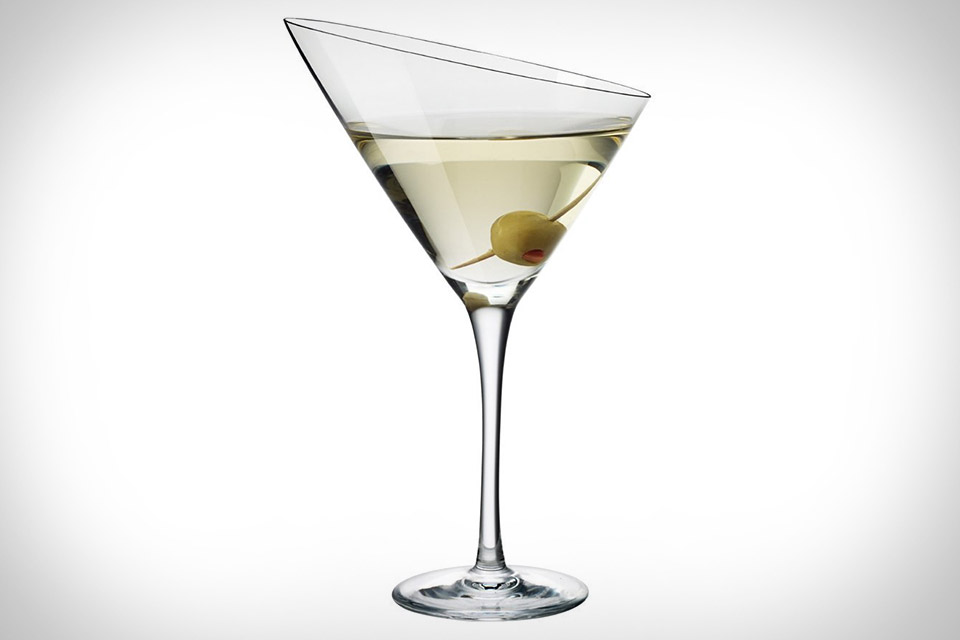 The standouts here are found among the 8-letter entries: I enjoyed the upper right pairing of MAHI MAHI, TRAVELOG, and HOMETOWN, the last with a misdirecting clue of [Roots locale], which had me thinking of the TV mini-series at first. Speaking of TV, we have TV CAMERA in the lower left, next to READ UP ON, which I first parsed as READ UPON, making no sense to me. A tenuous connection in the lower right with SUREFIRE and ARMS RACE, the latter clued as [Country competition], which had me thinking of wrassling matches and rodeos.
The standouts here are found among the 8-letter entries: I enjoyed the upper right pairing of MAHI MAHI, TRAVELOG, and HOMETOWN, the last with a misdirecting clue of [Roots locale], which had me thinking of the TV mini-series at first. Speaking of TV, we have TV CAMERA in the lower left, next to READ UP ON, which I first parsed as READ UPON, making no sense to me. A tenuous connection in the lower right with SUREFIRE and ARMS RACE, the latter clued as [Country competition], which had me thinking of wrassling matches and rodeos.
My FAVE entry was the unassuming [“Amo, amas, amat” class] for LATIN I, since I prefer to parse that as LATINI, or the gin-and-vermouth drink popular during the time of Caesar.
Patrick Berry’s Washington Post crossword, “The Post Puzzler No. 171″—Janie’s review
Years ago, in the ’80s, there was a holiday ad in which we heard a woman’s voice saying about the perfectly lovely watch she’d just received, “It’s nice. But I was hoping for a Longines…” (For those of you unfamiliar with the product, Longines makes very elegant—very expensive—time pieces.) Ouch, huh? Well, looking at my response to Patrick’s puzzle, I kinda feel like that dame today, thinking, “It’s nice. But I was hoping for a juicy Berry…” Am I alone? I hope you’ll put your 2¢ in, below in the comments section and/or above in the ratings.
So what’s my problem? For starters, when the marquee entry (the grid-spanner in the center here) is INTERNAL REVENUE and we’re nowhere near April 15th; when same entry is then clued literally as [Public funds, you might say] (which ultimately they are), I say, “That’s kinda dry.” Ditto the REFERRED TO / [Cited] and WHEREON / [Atop which] combos. And they get no help from the 9-letter, four-columned SE with its clinical MEDICATES and O-NEGATIVE beside the scarce-remembered, Warner and Universal-International contract-actress RUTH ROMAN and (straight-forwardly clued) TESTAMENT. Oh, and to their left, NAUSEATE, anyone? (Thank goodness COLON was clued in connection with punctuation.)
 No, it’s not OPEN SEASON (love that one) on Mr. Berry (also love DEER in connection with it—but “Bambi. Quick! The thicket!”). It’s just that so many of us are familiar with Patrick’s work, and he’s set the bar so darned high. It’s impressive to see 4×9 columns in a grid, right? Check out that NW grouping. With MODEL SHIP (and its visually suggestive clue [Something stuck in a bottle, perhaps]), AMERICANO, MANIFESTO and ART CENTER, it’s far livelier than its SE counterpart. And I like that, going across, it gives us the kinda arcane (for someone who never even knew about the kitschy 1978 Star Wars Xmas tv special [with its 2.9 (outta 10) rating from IMDB…]) but also kinda cool LIFE DAY. Elsewhere in the grid, END RHYME and TALL TALES and the descriptive BONE WEARY are all standouts (in want of much peppier, more indirect cluing, however [has the editor been asked to make these Sunday gems “easier”?]).
No, it’s not OPEN SEASON (love that one) on Mr. Berry (also love DEER in connection with it—but “Bambi. Quick! The thicket!”). It’s just that so many of us are familiar with Patrick’s work, and he’s set the bar so darned high. It’s impressive to see 4×9 columns in a grid, right? Check out that NW grouping. With MODEL SHIP (and its visually suggestive clue [Something stuck in a bottle, perhaps]), AMERICANO, MANIFESTO and ART CENTER, it’s far livelier than its SE counterpart. And I like that, going across, it gives us the kinda arcane (for someone who never even knew about the kitschy 1978 Star Wars Xmas tv special [with its 2.9 (outta 10) rating from IMDB…]) but also kinda cool LIFE DAY. Elsewhere in the grid, END RHYME and TALL TALES and the descriptive BONE WEARY are all standouts (in want of much peppier, more indirect cluing, however [has the editor been asked to make these Sunday gems “easier”?]).
 But how to reconcile those high points with the seemingly endless spate of proper nouns and names (SETON,
But how to reconcile those high points with the seemingly endless spate of proper nouns and names (SETON,  ACURAS, URDU, INDUS, ADOBE, JULY, PLUTO; DOPEY, OMAR, ERIC, ODETS, KELLY, DWIGHT, EVAN, OLAF, RUTH ROMAN (full name at least…), HORUS, ARES); and words that could be names—I’m lookin’ at you MORT, ALLY, ATOM, KEYS and DENT. Okay—it’s unfair to cite the last group, but in the context of the other names, they still jump out at me as I scan the grid. (And apropos of the picture at the left, yes, I know the puzzle refers to the astronomical PLUTO…)
ACURAS, URDU, INDUS, ADOBE, JULY, PLUTO; DOPEY, OMAR, ERIC, ODETS, KELLY, DWIGHT, EVAN, OLAF, RUTH ROMAN (full name at least…), HORUS, ARES); and words that could be names—I’m lookin’ at you MORT, ALLY, ATOM, KEYS and DENT. Okay—it’s unfair to cite the last group, but in the context of the other names, they still jump out at me as I scan the grid. (And apropos of the picture at the left, yes, I know the puzzle refers to the astronomical PLUTO…)
Is the grid perhaps too ambitious? At 66/28, there’s a low word and block count. And it has lots of open squares. And some strong acrosses: UP AND ABOUT, READS ALOUD, HOLIEST, MASCARA. Nice. And have you noticed? There’s not a three-letter-word in sight, which seems pretty amazing in and of itself. Still—does that accomplishment come at the expense of the overall quality of the remaining short fill? Perhaps constructors more experienced than I am could weigh in. Inquiring minds want to know!
So that’s it for today, folks. Except to cite the puzzle’s two anagram pairs: ABODE and ADOBE, and TERSE (which sits upon) ESTER. Sweet!
Emily Cox and Henry Rathvon’s CRooked crossword, “Indy Event” — pannonica’s write-up
I suppose, in retrospect, I should have solved this puzzle in a counterclockwise fashion. It’s all about the Indianapolis 500 auto race, which this year took place on 26 May, 7 weeks ago today, when this puzzle was published in the newspaper. In addition to the oval shape representing the racetrack itself, the grid is chock-full of related entries:
- 23a. [Number of competing drivers] THIRTY-THREE.
- 25a. [Pre-start parade] WARM-UP LAP.
- 39a. [Four-time spot for Castroneves] POLE POSITION.
- 56a. [The __ (Indy speedway)] BRICKYARD, Incidentally, the municipality where the it’s located? It’s called Speedway. Also, this nickname determined the color choice to highlight the oval shape.
- 81a. [Indy’s auto type] OPEN WHEEL.
- 104a. [Fastest stretch] STRAIGHTAWAY.
- 118a. [Like a finish flag] CHECKERED. See also 97d [Purina’s partner] RALSTON.
- 120a. [Where winners drink milk] VICTORY LANE. Louis Meyer, who inadvertently initiated the tradition in 1933, quaffed buttermilk. Modern drivers are offered a choice of whole, 2%, and skim. “At the 1993 Indianapolis 500, winner Emerson Fittipaldi, who owned and operated an orange grove, notoriously drank orange juice instead of milk following the win. He eventually relented and also drank milk later in the post-race ceremonies.” (Wiky500)
And then there are the shorter themers:
- 31a. [Luyendyk who won twice] ARIE.
- 36a. [Four-time winner Rick] MEARS.
- 53a. [Triple winner Franchitti] DARIO.
- 62a. [1986 winner Bobby] RAHAL.
- 79a. [2008 winner Scott] DIXON.
- 83a. [1969 winner Andretti] MARIO.
- 106a. [2006 winner Hornish] SAM.
- 107a. [Winner’s name nine times] UNSER. That’d include ALS senior and junior (31d [107-Across and son), and Bobby.
- 111a. [Four-time winner A.J.] FOYT.
Ancillary theme answers:
- 109a [From Speedway, IN?] LOCAL.
- 78a. [Old Indy-sanctioning org.] CART (“Championship Auto Racing Teams”).
- 16d. [500, for Indy] MILEAGE.
- 48d. [Service break] PIT STOP.
- 52d. [What 111-Across drove in 2011] PACE CAR.
- 56d. [Junqueira with six Indy starts] BRUNO.
- 83d. [Hulman who said, “Gentlemen, start your engines”] MARY.
- 94d [May 26, in 2013] RACE DAY.
Even more tangential clues/fill:
- 1a [Mazda roadster] MIATA. The Pro Mazda Championship is part of the “Road to Indy.”
- 71a [Crashes into] RAMS, 6a [Wowed crowd sounds] GASPS, 101d [First-aid pro] EMT.
- 44a [Likeliest to win] ODDS-ON.
- 51a [Top-billed wear?] CAP.
- 87a [Axle or rod] BAR.
- 91a [Muffle, as shock] ABSORB. Do racecars have mufflers? I can’t imagine they don’t have at least minimal shock absorbers.
- 105d [Driving gear] GLOVES; 102a [105-Down unit] PAIR.
- 110a [Assignment] SLOT.
- 114a [Piazza De Ferrari city] GENOA.
- 130a [Do the driving] STEER.
- 1d [Competed against] MET.
- 7d [Sticks] ADHERES, the way those wide tires do, on the track surface.
- 40d [Motor oil amount] ONE CAN.
- 57d [Came in second?] RAN UP. As in “runner-up.”
- 64d [Hard Drivin’ game platform] ATARI.
- 73d [Go over and over] REHASH. Over and over, as in the same track, 200 times.
I could even add some more, which are slightly greater stretches, but it’s probably best to quit while I’m (hopefully) ahead.
Finally, compared to my solve time of 10:28, the fastest in-race lap was achieved by Eddie Cheever, Jr. in 1996, who completed the two-and-a-half mile circuit in 38.119 seconds. In other words, he might have done 16.475 laps in the time it took me to finish this crossword. That’s 41.1875 miles (66.285 km)!
I’m exhausted.
Matt Skoczen’s syndicated Los Angeles Times crossword, “Border States”
Each of the words and phrases in this theme have “state borders”: Their first two letters and last two letters are 2-letter postal abbreviations of states. Given that there are 50 such abbreviations and only 16 of them are needed for this theme, having those circled squares doesn’t give much of a head start to the solver. It was pretty easy overall, though, despite one patently ridiculous crossing in the middle. 87a. [Periodic “Top Chef” judge with a restaurant in Manhattan]? I worked the crossings for that entire name, which is not remotely familiar to me despite my fondness for pop culture. I worked the crossings right up to that 80d. [Ukraine city]—also entirely unfamiliar to me! I gambled that WYLIE DUFRESNE was likelier than DeFresne (which is also a last name) and LUTSK sounded a bit better than LETSK, but it was pretty much a solving crapshoot. You can certainly be a well-rounded solver and never have heard of either 87a or 80d. Boo! Not such a fair crossing.
Because it’s Sunday evening already, let’s move on to five more things:
- 112a. [California city associated with the founding of Hells Angels], FONTANA. Trivia!
- 96d. [Allstate online subsidiary], ESURANCE. Hey! I just learned that Esurance was part of Allstate in a TV commercial yesterday. Allstate bought Esurance in 2011.
- 117d. [International Year of Astronomy year], MMIX. Or, as I call it, 2009. You have to know your Roman numerals here because the third letter crosses a three-letter abbreviation, 128a. [Music-licensing org.], BMI. You might consider BMX and MMXX, which would take you into the future and 2020. Although actually, the clue doesn’t promise that the date is in the past.
- 25d. [Gourd fruits], PEPOS. Generic term for the melon and cucumber family. Who knew? And now I understand why that cucumber in my salad (I rarely eat cucumber) reminded me of the edge of watermelon as you approach the rind and the flesh unsweetens.
- 70a. [“Horton Hears a Who!” villain], VLAD. Didn’t know this.
3.5 stars.
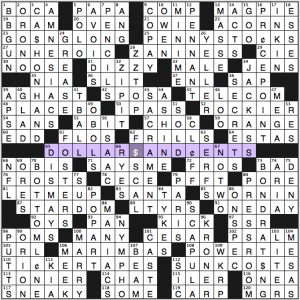
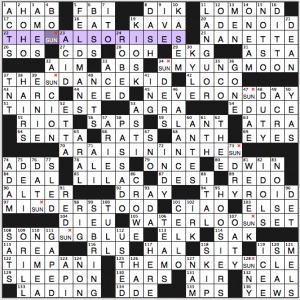
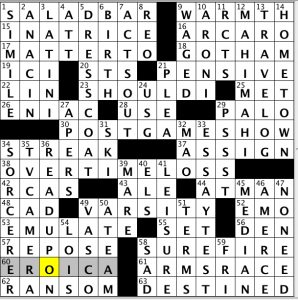

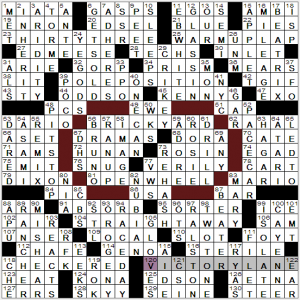
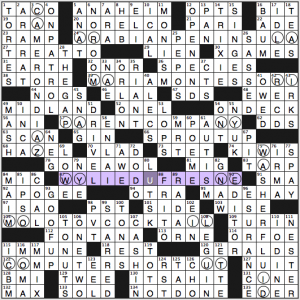
Re Amy on Merl’s puzzle:
” I am too young for this puzzle to resonate with me. This puzzle is patently aimed at the 55- to 75-year-olds out there. Wow.”
Maybe I’m misreading your tone here Any, but you give me the impression that you think this is a problem. Surely Merl can skew some of his puzzles to an older target audience now and then?
-MAS
“No, No Nanette” was on Broadway in the ’20s. There can’t be many solvers alive who saw its original run. Rather, we’ve learned interesting things about it. Like its tie to the Curse of the Bambino (Red Sox owner trades the Babe to the Yankees and uses the proceeds to invest in No, No Nanette) and it being the source of “Tea for Two.”
Most of the cited references were before my time, but I’m not ashamed to recognize them. That’s a big reason I enjoy crosswords.
Of course he can target his puzzles to whatever age group he wants. But if someone reviewing the puzzle is younger and that person didn’t enjoy it so much because of all the never-heard-of-that pop culture references, then the reviewer is not going to rave about it. Your mileage may vary.
I was going to say Patrick Blindauer did this as well as a Fireball offering (the S/I idea, not with the C/I), but maybe I was thinking of the BEQ instead.
I might be overly critical, but it did bother me that there were I’s, C’s and S’s in the theme entries that did not get the crossing treatment. And for those that did, I wish that one in the upper left had the S going across and the I down (like the other 5).
Can you tell I didn’t get much sleep last night? ;)
Although I filled in all the squares, I still couldn’t figure out how to interpret the dollar and cent symbols. Therefore, some of my fill didn’t make “cents:” (sense). Didn’t enjoy this puzzle because when the clues didn’t require superimposing one letter over another the remaining fill was very easy. The title “show me the money” was tantalizing because while it immediately clued me into the answer “Dollars and cents” I simply didn’t “get” how to use the dollar and cents symbols. And that made me feel dumb. Arrgggg!
You’re not alone. Perhaps we didn’t pick up on some subtle clue that indicated that the solver was supposed to use the money symbols in place of the letters S and C, or that those symbols represented the letter I in the crossings. I still don’t understand the rationale behind that. The clue at 65A made no sense to me, at all. I don’t understand how one “letter can be superimposed over another”. Are dollar and cent signs considered letters?
Amy’s explanation didn’t offer much help. That she thinks the dollar and cent signs becoming the letter I is “incredibly nifty.” That does nothing to resolve the issue for me. In fact, I had a hard time understanding much of Amy’s write-up. She says the “financial long answers intersect in the corners and the middle”. I don’t see them intersecting at all.
Amy didn’t let on why she wasn’t gnashing her teeth over how to figure out the electronic solution. Using Across Lite, I left those offending squares blank, hoping to find the answer here. Has anyone determined the proper notation that the software will accept?
I also thought the rest of the puzzle to be average for Sunday fill, perhaps leaning toward the easy side. Most of the clueing seemed straight forward.
I had problems too, but banged it into submission. Here’s what it looks like, complete with black-flag triangles.

I’m not sure I follow. The “black-flag triangles” indicate a wrong fill, yes? I want to see the happy pencil guy, the message that says the puzzle is complete and correct.
I had little problem working the puzzle. As I said, I thought it to be on the easy side. I just don’t know what to put in the squares that have a letter and a symbol in them that Across Lite will accept.
The “black-flag triangles” indicate that those boxes had at one point been filled in improperly (marked then with “red-flag triangles”) when I checked the solution.
After finding the intended characters for each box and rechecking the grid, those problem squares turned black.
In other words, had I from the start entered the solution as you see the letters in the grid, it would have been correct and “clean.”
(edit: Also, I see that there are some non-special crossing mistakes there. Those can be chalked up to carelessness, confusion, and/or confusion borne of the special intersection requirements.)
@Papa John – the letters that are superimposed are a C and an I (to make a cent sign) or an S and an I (to make a dollar sign).
I’m also in the (apparently very small) camp that didn’t find this puzzle all that exciting. Theme was kind of cute, but overall it was just pretty easy. I prefer a Sunday that’s a little more challenging – makes taking the time to fill in all those squares more rewarding (this one felt more chore-like).
Thanks.
I already figured out the $ piece before I even read the clue for the central answer. It think the clue gave away too much. Adding the info about the superimposing letters wasn’t necessary and was too much of a giveaway. Anyone object to FROSTS? It left me cold.
I thought the puzzle was brilliant. I caught the theme quickly and except for OBOLS, did not have any difficulty with the fill.
Last night, I listened to much of a one-hour infomercial for rock and roll music of the late ’50s. I knew every song, but could not associate most of the songs with the singer or group. I forgot how great the Platters were. I will now switch to Merl’s puzzle. Nice to know the Boomers are getting some play.
Steve
NYT: Does anyone else think it’s cool that Daniel Finan’s last name represents the start of Finance? No?
I tumbled to the trick very early where the S/I was concerned, and got the Dollars and Cents central answer which clued me into the C/I. Still, I would get hung up on these intersections. I stared at FSSCAL CLCFF dumbly before I tumbled to the need to turn it into FISCAL CLIFF in my head.
And Across Lite was most definitely annoying. It should accept “SI” or “IS” interchangeably, or else it should be consistent and take only one. But not so. The intersection of 3 Down and 23 Across requires IS whereas the intersection of 73 down and 112 across requires SI if you want to see a Happy Pencil at the end… Weird.
It just occurred to me that Across Lite is forcing you to enter the rebus letters (SI or CI) in the order determined by the Across answer first and the Down answer next. That’s way too picky.
I found that using the appropiate letter of the across fill, such as 23A GOING LONG” or 25A PENNYSTOCKS fills the bill nicely in Across Lite. Inserting SI or CI didn’t work for me. It took some doing to come up with that. Had I not participated in this thread, I wouldn’t have bothered. I simply wasn’t blown away with this puzzle.
I agree with Dook with “frosts”. Puzzle was a slog & I still am scratching my head over the whole concept. Not fun!
Agree with the comments that this was not fun. And most keyboards don’t have a “cents” symbol, do they? This was a slog. And here’s a nomination for the worst all-time clue-and answer: 81A. Ugh. How did this get a 4plus star rating.
GG, on the Mac, option-4 generates the ¢ symbol. (Shift-4 is $.) Windows makes it much more cumbersome, but I’m on a Mac and enjoyed the ¢/$ action.
I normally savor “gimmick” puzzles, but this one was plain tedious. The “see 77D” sort of clues are a royal pain, especially in AcrossLite. I for one was pleased to finish it and get it out of my life.
You know, at a distance, this NYT is superb. Clever gimmick (even though BEQ debuted it a while back), and overall high-quality surrounding fill — I gave it 5 stars. What doesn’t make sense to me is how much I hated solving it. For the first time in a really long time, I was tempted to quit solving mid-puzzle because I was so bored. I was ready to chalk my solving experience up to “I’m having a bad day” until I saw that many of the commenters had the same experience, the words “slog” and “tedious” appearing frequently in solver’s reviews.
My theory is that this puzzle is a bit of a double-edged sword. On the one hand, if you didn’t figure out the gimmick until late in your solve (or not at all), then most of your time was spent beating your head against the wall; on the other hand, if you figured out the gimmick too quickly, then the rest of the solve felt like a really big Monday puzzle. Maybe for others this felt less like a chore, and maybe if I solved this puzzle again in two or three years I would feel the exact opposite way.
I recently heard an interview with David Foster Wallace, in which he said something interesting about the craft of writing that I think applies similarly to crossword constructing: “[It’s] empty and frustrating . . . for a reader [solver] to invest their time and attention in something and to feel that the agenda is basically to show you that the writer [constructor] is clever.” To be clear, I don’t think that applies to this puzzle, but I can think of recent puzzles to which it does apply. Just hoped that might be interesting to someone.
Agreed!
LAT : Border States – Each pair of states border each other.
Amy, re Reagle:
At first I wasn’t going to defend Reagle’s puzzle to you, because if the entries don’t resonate with you, they don’t, and there are lots of things I don’t know and have missed out on also. The arguments for a puzzle that would have a few contemporary clues remain, even if I might find less that resonates for me in that hypothetical puzzle. But Waterloo Sunset is so great, and short! It’s three minutes. Give it a try!
Here’s the song as performed at the London Olympics, with the unhappy comments below about the song’s being cut by NBC for its broadcast:
http://www.youtube.com/watch?v=C_HXRl8F6Mk
Here’s the original version, I think:
http://www.youtube.com/watch?v=5J3gX47rHGg
As far as my phrase “The arguments for a puzzle that would have a few contemporary clues remain” goes, I take it back, I don’t want it! But I still recommend the song Waterloo Sunset to anyone, and you can recommend things to me!